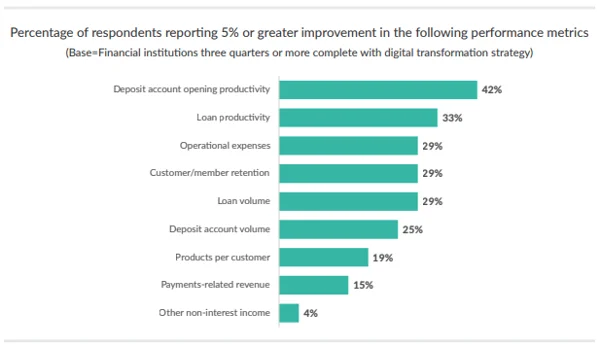Digital transformation looks different for every industry.
For banking, the change has been nothing short of an evolution. The industry has shifted from being digitally resistant and paper-based to fiercely competitive in a digitally disruptive market. However, compared to other industries, banks, and financial institutions have not been at the front of this shift.
As more and more people move to online shopping and other smartphone apps, banks have had to adapt their operating models to gain a competitive advantage. Digital transformation in banking requires a comprehensive digitization strategy that covers everything from customer engagement to back-end operations.
What is digital transformation in banking?
Digital transformation in banking is the integration of technology into bank operations, leading to fundamental changes in the ways banks function and deliver value to customers. When executed successfully, banks are getting better at competing in a crowded market.
Digital banking platforms allow banks to offer a host of digital financial products across multiple channels to meet customers wherever they are. Thanks to this software, the transition of traditional banks from brick-and-mortar to digital banks has been relatively smooth.
The pandemic accelerated this change, but digital transformation in banking started way before 2020. Of course, customers now expect seamless multi-platform access for any service they use – daily banking and financial services are no exception.
While banking hasn’t changed at its core, how the industry works with customers has. New players like fintechs and neobanks are offering personalized experiences so customers feel more in control of their finances than ever before.
The four areas of digital transformation
To embark on the digitization journey, a business has to modify four main areas.1. Process transformation makes company operations more efficient and effective. Methods like process mining help organizations identify areas of improvement.
2. Business model transformation reinvents the traditional business model for success. New business modeling allows organizations to create an efficient workflow that leads to growth and new opportunities.
3. Domain transformation creates value by tapping into new opportunities. The adaptation of technology can redefine products and services, paving the way for businesses to establish authority in other sectors.
4. Culture transformation for understanding, embracing and advancing digital change across the business. It Allows organizations to go beyond redesigning products by promoting the shift from within.
Importance of digital transformation in banking and financial services
Digital engagement is key for optimizing the customer experience. Some banks have resisted shifting from their tried and tested methods, but most see the value that digitization brings to their services. From process competency to increased customer reach and satisfaction, digital transformation in the banking industry has consistently optimized operations.
According to a survey conducted by Cornerstone Advisors, 42% of institutions said they’ve achieved a 5% improvement in deposit account opening productivity, and 33% said they’ve improved loan productivity by 5% or more.



Analysis: As much as this article addresses how banks can accomplish a digital transformation, it is more valuable to focus on its holistic overview of digital banking, including its importance and its challenges, along with the technology and business changes that occur to run a digital bank. It shows how digital bank efficiency allows for easier customer acquisition and in some areas a more personalized banking experience. On the other hand, however, it also critiques digital banking because of certain security obstacles, and the remaining demand for local branches and person-to-person interaction. It helps one think about the importance of balance, especially in the finance industry. It questions how banks can design a business model that will compromise between the benefits of traditional and digital banking? It points out the need to truly understand who the Huntington customer is because key factors, such as demographics, lifecycle, and product mix, will influence if certain digital changes will actually produce growth for the company and customer.
Citation:
The rise of digital transformation in banking: Why it matters – G2. (n.d.-b). https://www.g2.com/articles/digital-transformation-in-banking

![G2CM_FI591_Learn_Articles_Images-[Digital_transformation_in-banking]_V1b](https://desis.osu.edu/seniorthesis/wp-content/uploads/2023/08/G2CM_FI591_Learn_Articles_Images-Digital_transformation_in-banking_V1b.png)


